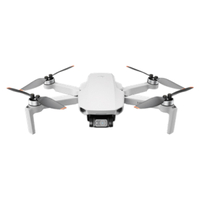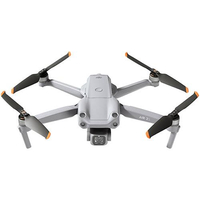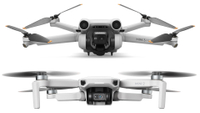TechRadar Verdict
So near to success, but now probably in the firing line of the DJI Mini 3 Pro. The Nano+ might have been the drone to own had it arrived with complete software and fewer issues. To really compete with DJI, it'll likely need to become much cheaper.
Pros
- +
Big sensor and bright lens
- +
Collision detection
- +
Stunning video and stills
- +
Air 2S features in a 250g drone
Cons
- -
Fragile
- -
Still missing subject-tracking
- -
No API support
- -
Controller needs a redesign
Why you can trust TechRadar
Two-minute review
Autel has spent the last few years trying to convince drone owners that good drones are made by companies other than DJI. It had some success with the Evo II, but it took the announcement of a new generation of Evo series drones to really convince drone fans that it could take on the market leader with highly innovative products.
That initial announcement was in August 2021, but it took till early 2022 before the excellent Autel Evo Lite+ arrived, to be shortly followed by the Evo Nano+.
Initially, both designs had issues, although those on the Lite+ seemed less concerning than the reports about the Nano+ and its performance in so-called 'Ludicrous' (or sport) mode.
Since then, Autel has been trying to fix these problems and add features that didn’t make it into the original release, while also trying to keep existing customers happy.
A great drone for beginners, Evo Nano+ is a sub-249g drone that is physically similar to the DJI Mini 2, using the same folding arm ergonomics to make it highly portable and quick to deploy.
But where the DJI Mini two was more of a stripped-down design, the Nano+ has many features that DJI Air 2S owners enjoy. These include obstacle avoidance sensors, a sizable 1/1.28-inch sensor for capturing 4K video in low light conditions and up to 48MP still images, plus an enhanced communication system for long-distance flying.
The camera on the Nano+ is the lure here, as it uses a much larger sensor than was on the DJI Mini 2, but also has an f/1.9 aperture that allows many more photons to hit that sensor. The available ISO range is 100 to 6400 ISO, and the maximums shutter speed is 8,000ths of a second.
The results can be stunning for a mini drone, and with the possible exception of the DJI Mini 3 Pro, this drone is capable of better image and video quality than any other sub-249g drone.
The maximum video resolution is 4K at 30fps, and the bit rate is 100Mbps. Images up to 8192 x 6144 resolution can be captured, although the sensor is technically only 12MP and the 48MP mode involves some interpolation.
Battery life is a respectable 28 minutes, and those buying the Premium Bundle will have three of those to multiply the total flying time to 84 minutes.
It uses the same controller as the Evo Lite+ offering a theoretical 10km video transmission range over Autel Skylink technology.
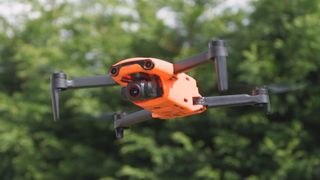
Price and release date
Design and controller
Features and flight
Video and image quality
Should I buy it?
For those who find flying near trees and buildings stressful, the Nano+ has three-way obstacle avoidance allowing it to detect structures that are in front, behind and below it while flying in Smooth or Standard mode. The detection technology is image-based and therefore won’t work at night and is disabled when the drone is flying at maximum speed using ‘Ludicrous’ mode.
In common with other designs in the Evo series, the Nano+ comes in signature Autel Orange, Arctic White, Deep Space Gray, and is also available in Red.
The small, light-grey elephant in this room is the newly launched DJI Mini 3 Pro, another mini drone design with many similar enhancements as the Autel Evo Nano+, but at a lower price.
Autel Evo Nano+ price and release date
- Announced on August 28, 2021
- Standard kit costs £719 / $949/ €977
- Premium Bundle costs £859 / $1,049 / €1199
When you consider that the DJI Mini 2 can be bought for £419 in the UK and $449 in the USA for the standard package, the cost of the Evo Nano+, even in the Standard kit form, is a shock to the system.
As drone flyers might expect, the Evo Nano+ is also available in a premium bundle that includes many extras, including more batteries. The standard kit consists of the drone, controller, one battery, propellers, and charger with all cables, costing £719, $949 or €977 depending on your region.
An additional £140 ($100) snags you the premium bundle that includes two more batteries, a soft carry bag, three prop replacements and a multi-battery charger. What’s missing, included on the Evo Lite+, are any ND filters.

Autel offers the cheaper Nano model, but this lacks the big video sensor that the Nano+ packs.
As a next step from the DJI Mini 2, the Autel Evo Nano+ looks like an expensive upgrade, even if it does have a significant number of enhancements over that design.
More of a concern for Autel is that it's undercut by the new DJI Mini 3 Pro a little, and you can get that drone even cheaper if you already have a DJI Mini 2 and use the controller from that hardware to control the new drone.
Design and controller
- 1/1.28-inch sensor with a f/1.9 lens
- Collision detection
- Same controller as Lite+
On initial inspection, the Evo Nano+ doesn’t diverge hugely from the path that the DJI Mavic Pro first trod back in 2016, with its folding arm concept.
Physically, it's a very similar size to the DJI Mini 2, though Autel has made some interesting design choices, presumably to reduce weight.
Sensor: 1/1.28 inch (0.8 inch) CMOS
Video/max frame-rate: 4K/30p, 2.7K/30p, 1080/60p
Max bit-rate: 100Mbps
Stabilization: 3-axis gimbal
Transmission: Autel SkyLink
Max flight time: 28 mins
Weight: 249g
Dimensions (folded): 142 x 94 x 55mm
Dimensions (unfolded): 260 x 325 x 55mm
Where the Lite+ seemed solid and able to handle the odd knock, the Nano+ is decidedly less robust, and the body has more flex than is ideal in a few locations.
Much of the inherent rigidity of this design comes from the battery, and without this installed the Nano+ should be handled carefully.
Unlike the DJI Mini 2, the Nano+ has no rear battery cover door, and the power button is conveniently integrated into the battery.
The batteries are rated at 2,250mAh (17.32Wh), weigh 83g and therefore represent roughly a third of the total mass of the Nano+. These provide a quoted 28 minutes of flight time, which usually translates into a practical 25 minutes of actual operation.
That’s a little less flying time than the DJI Mini 2 or Mini 3 Pro, but enough to get some use out of the drone before considering returning to the take-off point.









While we don't have any official confirmation of this hunch, it looks like the designers of the Nano series took much inspiration from the DJI Mini 2 specification and included at least three features here that are significantly better than that top-rated product.
The first of those is the 1/1.28-inch CMOS sensor coupled with an impressive PDAF (or phase-detection) and CDAF (contrast-detection) dual autofocus lens with an f/1.9 aperture. This sensor uses RYYB technology to further boost the contrast range, allowing for exceptional results in low-light conditions.
While the sensor is an improvement over the one in the Mini 2, it can still only capture video with a maximum resolution of 4K at 30fps. Overall, at that resolution, the video quality exceeds the DJI Air 2S in some situations, though that drone can shoot in 5.3K.




The second enhancement is three-way obstacle avoidance, with sensors pointing forwards, rearwards and below. No side sensors, but at least these should stop you from reversing into a tree or house.
The final improvement over the DJI Mini 2 is the Autel Skylink connection technology. Based purely on specifications, it appears to be on par with DJI’s Ocusync 3.0 and a significant improvement over the Ocusync 2.0 used on the Mini 2.
The Nano+ uses the same controller that came with the Evo Lite+, which is easy to use, responsive and has a fantastic range of up to 10km (in the USA, less in Europe).
Of course, it's important to note that flight restrictions in most regions don’t usually allow you to fly that far away. But for those prepared to follow the rules, the chance of becoming disconnected from the drone within visual range is very low, even in locations where there is lots of interference from other wireless technology.
Our only reservations about the controller are that there is no place on them to store the thumbsticks, and for whatever reason, when connected to a phone, the controller insists on charging that device, reducing the battery life significantly.
As a result, the controller struggles to last long enough for three full batteries of flight, and the idea of the controller losing power while the drone is airborne isn’t one we’d embrace.
Features and flight
- HDR and Log modes
- Great transmission range
- Tracking still to come
Our experience with the Nano+ was somewhat mixed. To be blunt, to bring you this review, we utterly demolished one of Autel’s Evo Nano+ drones.
It was an unfortunate accident where the drone climbed vertically to 17.8m before it lost all power and subsequently crashed onto some concrete paving, smashing it into tiny pieces.
We’re unfortunately no wiser as to why that happened now, as the telemetry contained no clues – and before its untimely demise, the same drone had made several much longer flights without any issues.
Thankfully, Autel replaced that very broken drone with one that had all its motors attached, and we got to experience what the Nano+ truly has to offer.
When it takes flight, the Nano+ is quite like the Mini 2 in feel, and anyone with experience with that drone should feel immediately confident with this one. It’s highly controllable, and collision detection provides a degree of confidence when moving around houses and trees at a low level.
Our only issue with collision detection is that sunlight hitting the sensors directly can cause the detection system to see something that in reality doesn’t exist. This can result in a proximity warning while the drone is cruising at 300ft or more, which is mildly off-putting and can ruin a perfectly good shot.
It doesn’t take much to disable the feature, but some work on avoiding these false readings might help make it more helpful and less annoying.
An issue with this drone in its initial release was its inability to achieve the attack angle needed for maximum speed. Autel has released several firmware updates with progressive improvements to flight performance.
With the latest update, the Nano+ can hit the quoted 15m/s top speed using 'Ludicrous' mode, something that those who fly in gusty conditions will require to return against the wind.
While we’d prefer to take the DJI Air 2S or Autel Evo Lite+ into the strongest winds, the Nano+ isn’t poor at coping with these conditions, unlike the original DJI Mini.




Fly the Evo Lite+ up to a kilometer away, and the transmission system relays good quality video back to the phone or tablet, enabling a clear view for those flying the drone.
Once beyond that range, the quality drops to 720p, though in line-of-sight tests, we managed to go much further out and retain both clear images and precise control of the drone.
If the Nano+ disconnects, it can return to the launch point unaided if that was your choice in the Fly application. When executing a return-to-home, the obstacle avoidance is active, causing it to stop, but it won’t fly around anything that it finds in its path.
It seems unlikely that Autel will add automated navigation of that type to the Nano+, though the Autel Fly application has already undergone several major changes since we used it with the Evo Lite+.
Many of these are to do with the camera that we’ll discuss later, but the application has been getting a series of updates that both fix known issues and add new functionality.


The promised feature that is still missing is active subject-tracking, enabling the drone to lock onto a person, animal or vehicle and keep it framed by the camera even if it moves.
Our experience is that even when this feature finally arrives, we’d be cautious about using it. This drone has no sideways sensors, and collision-detection can miss thin twigs, wires and fast-moving wildlife.
What it does have are the typical automated shots where you pick a subject, and the drone flies around that point or zooms away in a classic drone style.
There is nothing revolutionary about any of these automated shots, but the camera and its capture options provide something that, before the Nano+ launched, wasn’t available on a drone weighing less than 250g.
Video and image quality
- 1/1.28 inch (0.8-inch) CMOS sensor
- Excellent low-light results
- HDR and A-Log capture
When mini drones first appeared, flyers learned to accept some compromises as to what they could do, along with the quality of the video and still photography they could produce.
The Autel Evo Nano+ takes those concepts and shreds them, providing image quality that we’d have associated with a much heavier and more expensive drone last year (before the arrival of the DJI Mini 3 Pro).
Where this 1/1.28 inch CMOS sensor is exceptional is in the amount of dynamic range it offers, making it highly suitable for shooting in low-light conditions without introducing excessive amounts of grain.
However, the rush to get this product to market has undermined it somewhat in the modes it can operate in and the settings available for the cinematographer to exploit.
While we’d have loved to have seen 4K at 60fps, the quality of the 40K at 30fps on this drone is good and better than we’ve seen from many prosumer designs.
A slight disappointment is that the maximum frame-rate in 2.7K is only 30fps and 1080p is 60fps, making 1080p the only mode that allows for any degree of slow-motion shooting.













Other issues that we’ve noticed include the oversharpening of the image using the default settings and the HDR mode.
It is possible to shoot in a 10-bit A-Log mode, and then apply the amount of sharpening and grading required in post-production, extending the workflow.
The only problem with A-Log is that the Fly application doesn’t provide a means to colour the screen to aid in flying, making using this mode even more of a challenge.
Since we reviewed the Lite+, the way that the Autel Fly application reveals camera control has radically changed, mostly for the better. Previously different controls were used for video and still images, but now these are brought together under a ‘shoot’ menu with common settings.
However, there are still just two control levels, with 'Auto' and 'Manual' modes. Confusingly, HDR and A-Log video modes are also only available with Auto exposure mode, not with manual settings.
Why you can’t capture in Log, for example, but have control over the frame-rate, or aperture, is a mystery, and we hope that it is something Autel changes soon.
Due to gusty conditions, getting a stable hyperlapse proved a challenge in our tests, but it is possible to stabilize it in post-production reasonably easily. What's required is the option to use 2.7K with auto stabilization.
Our night shoot was less difficult and showed how much light this sensor can capture. One mistake we made was that we left the camera in 'auto' exposure. When playing back the footage there is a clear difference between that in ISO 3200 and ISO 6400, with the latter having much more grain. We'd recommend locking the ISO to 3200, as the results are markedly better.
There are also some slightly curious restrictions on still images, specifically that it can only shoot single images in the highest 48MP resolution. The fact that you can’t use this mode for panoramas is odd, and it only captures in JPEG at this resolution. Those restrictions make it less useful, though it might be useful for creating maps.
In both video and still capture some work still needs to be done by Autel to get the most out of this sensor and lens combination. But some of the recordings and images we’ve taken with it provide strong evidence that the extra development effort will almost certainly be worth it.
Should I buy the Autel Evo Lite+?
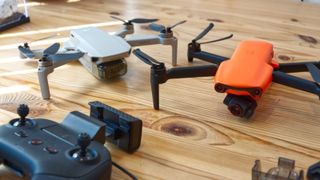
Buy it if...
You like night and low-light photography
The camera sensor on this drone is far better than the one on the DJI Mini 2 and even the DJI Air 2S, allowing it to capture more light in challenging conditions. This makes a big difference if you want to capture a city at night or a sunset, as the range from the darkest parts of the image to the brightest is much greater. For low-light enthusiasts, the Nano+ has plenty to offer.
You are concerned about rule changes (in Europe)
While the Nano+ doesn’t have the EU's forthcoming ‘C’ labels, what it does offer is a high-performance drone under 250g, which makes it easier to fly legally in many locations in the UK, Europe and the USA. With changes coming in the EU that could curb where drones like the Air 2S can be flown, the Evo Nano+ offers many of the advantages of a bigger drone, but keeps under the critical weight limits.
You’ve given DJI enough money already
The drone market is still largely owned by one company, and that's not always healthy for choice. Based on the Evo Nano+, Autel can be the competition that DJI needs, so that drone fans continue to get innovative designs at affordable prices. For that to happen, Autel must sell more drones, like those in the Evo range. Being ‘different’ would be easier if DJI would release a poor drone design now and again.
Don't buy it if...
You want to stick with DJI
While DJI has had its issues, most recently with the Mavic 3, it has a strong track record of resolving problems, usually quickly. Many drone fliers looking at the Nano+ will already have experienced the DJI Mini, Mini 2 or Mini SE, and for them, the DJI Mini 3 Pro is a natural progression. That’s understandable, as the software you already know is always easier than an application you’ve never seen before. The Mini 3 Pro is also a little cheaper and has the new RC controller with an integrated screen.
You use third-party applications
Currently, Autel doesn’t offer an API to allow external companies to develop software tools for their drones. DJI has recently added the Mini 2 and Air 2S to the list of drones that have API access, allowing applications like Litchi, Dronelink and Rainbow to fly them. We guess that while Autel has said it is considering an API, it also wants to keep features like waypoint missions for its professional products, and third-party apps could add this to the Nano+ and Lite+.
You like to fly in windy conditions
The current kings of windy weather flying are the DJI Mavic 3 and Air 2S, as these have the weight and power to cope with extreme conditions. According to the makers of those drones, the DJI Mini 2, Autel Evo Lite+ and Evo Nano+ all share the same Level 5 wind resistance, meaning they can cope with 19-24mph (29-38kph) gusts. However, these drones aren’t equal, and we’d place the Nano+ closer to the Mini 2, but behind the Mini 3 Pro, in this department. The difference isn’t huge, but for those wanting a drone for flying in the wind, the Evo Nano+ might not be the right choice.
Also consider
If our Autel Evo Nano+ review has you wondering about alternatives, here are three rivals to consider.
DJI Mini 2
For those wanting to get into drone flying and cinematography, the DJI Mini 2 provides the perfect starting point. Critically, it's much cheaper than the Autel Evo Nano+, Nano or DJI Mini 3 Pro, making it less of an issue if this isn’t a hobby that you ultimately pursue. The Mini 2 is a well-made drone with lots of solid features, including 4K video recording and the recent release of an API allows it to be flown using third-party apps like Litchi.
DJI Air 2S
While the Air 2S is probably due for replacement soon, it is still considered one of the best drones for filmmaking, and it doesn’t cost much more than the Nano+. However, the Air 2S weighs in excess of 250g and does have more restrictions on where it can fly, with more EU limits likely in the future. Its advantages over the Nano+ are a longer flight time, better performance in windy conditions and a camera capable of 5.3K recordings. It also has intelligent flight modes and sensors that point in four directions, including up.
DJI Mini 3 Pro
The DJI Mini 3 Pro isn’t a revamp of the Mini 2, but an entirely new drone with an impressive feature set that rivals many professional drones. It can record 4K video at 60fps, vertical video, 120fps slow-motion, and 50MP still images, all with a 1/1.3-inch CMOS sensor. The Mini 3 Pro is a remarkable piece of kit that can be bought without a controller for those who have a Mini 2 and its controller. Other options include the same controller or a new DJI RC controller that negates the need to carry a phone. For those who already own a Mini 2, the Mini 3 Pro is a cheaper option than the Autel Evo Nano+.
Mark is an expert on 3D printers, drones and phones. He also covers storage, including SSDs, NAS drives and portable hard drives. He started writing in 1986 and has contributed to MicroMart, PC Format, 3D World, among others.

